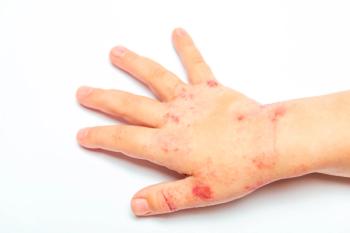
- Consultant for Pediatricians Vol 8 No 10
- Volume 8
- Issue 10
Two-Year-Old Boy With Recalcitrant “Diaper Rash”
A 2-year-old boy brought for pediatric dermatology consultation because of the "worst diaper rash in the world." Mother reported that the rash had been present for a year and was asymptomatic. She had been using topical barrier creams, corticosteroids, and antifungals to treat the area. Child had also received a course of oral antibiotics. Occasional improvement of rash noted but never complete resolution. Patient had no other medical problems. Family history noncontributory.
HISTORY
A 2-year-old boy brought for pediatric dermatology consultation because of the "worst diaper rash in the world." Mother reported that the rash had been present for a year and was asymptomatic. She had been using topical barrier creams, corticosteroids, and antifungals to treat the area. Child had also received a course of oral antibiotics. Occasional improvement of rash noted but never complete resolution. Patient had no other medical problems. Family history noncontributory.
PHYSICAL EXAMINATION
Six 0.5- to 1-cm erythematous papules and nodules confined to the penis, scrotum, upper thigh, and inguinal folds. Lesions were nontender and freely mobile. No other lesions present. Punch biopsy of lesions performed.
WHAT’S YOUR DIAGNOSIS?
(
ANSWER: INFANTILE MYOFIBROMATOSIS
The punch biopsy specimen demonstrated spindleshaped cells in interweaving fascicles embedded in a fibromyxoid stroma. Immunohistochemical stain results were positive for actin and vimentin and negative for desmin and S100 protein. These findings confirmed the diagnosis of infantile myofibromatosis.1,2
Infantile myofibromatosis is a benign mesenchymal neoplasm of myofibroblastic origin. The entity was first described in the 1950s by Stout3; the current terminology was introduced in 1981 by Chung and Enzinger.4 Although rare, infantile myofibromatosis is the most common fibrous tumor of infancy and childhood; about 300 cases have been reported.5 It is an important consideration in any infant who presents with solitary or multiple nodules.
CLINICAL CHARACTERISTICS
Infantile myofibromatosis is characterized by tumor formation in the skin, soft tissue, muscle, bone, and viscera.6 Bone involvement occurs in about 50% of cases and manifests as lytic metaphyseal lesions that spontaneously regress over several years.6 The lesions are usually asymptomatic. The typical presentation is a firm, flesh-colored or erythematous to violaceous nodule visible or palpable on the skin, muscle, or subcutaneous tissue, although any organ can be involved.
The disorder is classified into 3 types: solitary (more than 50% of cases), multicentric (more than 33%), and generalized (less than 15%).7 In patients with solitary lesions, the most common sites of involvement are the head and neck regions. Solitary lesions are more common in boys, whereas multiple lesions (the multicentric form) are more common in girls.8,9 In patients with the multicentric form, confinement of lesions to the genital area, as in this boy, is unusual.
The solitary and multicentric forms have a good prognosis and benign clinical course with a high rate of spontaneous resolution via apoptosis. Recurrence later in childhood is uncommon.7 Generalized infantile myofibromatosis, which is characterized by multiple lesions and visceral involvement, often has a poor prognosis and significant morbidity and mortality.6
About 60% of cases of infantile myofibromatosis are congenital, and 90% of the lesions develop by 2 years of age.10 Most cases are sporadic, although there have been some reports suggestive of an autosomal dominant pattern of inheritance.9
DIFFERENTIAL DIAGNOSIS
The differential diagnosis includes granuloma gluteale infantum, fibrous hamartomas of infancy, scabietic nodules, leiomyomas, juvenile xanthogranulomas, hemangiomatosis, mastocytosis, cutaneous metastasis, and fibrosarcomas.
EVALUATION AND MANAGEMENT
When evaluating a child with suspected infantile myofibromatosis, the first step is to confirm the diagnosis via biopsy and then determine whether skeletal and/or visceral systems are involved, especially in patients with multiple lesions. This can be accomplished through various imaging modalities, such as a skeletal survey, chest radiograph, echocardiogram, abdominal ultrasonogram, or MRI scan.
The space-occupying nature in some anatomic areas may interfere with vital functions. In patients with severe involvement, chemotherapy has been used. Surgical excision is warranted only when vital organ function is affected by the lesion; otherwise, observation is optimal.5
OUTCOME
At follow-up, this patient’s lesions were resolving and his mother did not wish to pursue further evaluation.
References:
REFERENCES:1. Ichihashi K, Takenaka H, Asai J, et al. Infantile myofibromatosis of the scrotum.Eur J Dermatol. 2008;18:82-83.
2. Val-Bernal JF, Garijo MF. Solitary cutaneous myofibroma of the glans penis. Am J Dermatopathol. 1996;18:317-321.
3. Stout AP. Juvenile fibromatoses. Cancer. 1954;7:953-978.
4. Chung EB, Enzinger FM. Infantile myofibromatosis. Cancer. 1981;48:1807-1818.
5. Gopal M, Chahal G, Al-Rifai Z, et al. Infantile myofibromatosis. Pediatr Surg Int. 2008;24:287-291.
6. Pelluard-Nehmé F, Coatleven F, Carles D, et al. Multicentric infantile myofibromatosis: two perinatal cases. Eur J Pediatr. 2007;166:997-1001.
7. Nino T, Woodhall K, Soeprono F, Chase DR. Solitary nodule in a 3-month-old infant. Arch Dermatol. 2008;144:405-410.
8. Zhou DB, Zhao JZ, Zhang D, Huang XY. Multicentric infantile myofibromatosis: a rare disorder of the calvarium. Acta Neurochir (Wien). 2009;151:641-646.
9. Arcangeli F, Calista D. Congenital myofibromatosis in two siblings. Eur J Dermatol. 2006;16:181-183.
10. Ang P, Tay YK, Walford NQ. Infantile myofibromatosis: a case report and review of the literature. Cutis. 2004;73:229-231.
Articles in this issue
about 16 years ago
It Takes a Village to Treat ADHD: Community and Clinical Collaborationsabout 16 years ago
Lichen Striatus on the Arm of a 7-Year-Old Girlabout 16 years ago
Herd Immunity:Another Good Reason to Vaccinateabout 16 years ago
Vaccinating theImmunocompromised Childabout 16 years ago
Point-Counterpoint:Responding to Common Reasonsfor Vaccine Refusalabout 16 years ago
Gunshot Woundabout 16 years ago
Henoch-Schönlein Purpura in an 18-Year-Old Boyabout 16 years ago
Pityrosporum Folliculitisabout 16 years ago
Pediatric Immunization Update-2009Newsletter
Access practical, evidence-based guidance to support better care for our youngest patients. Join our email list for the latest clinical updates.









